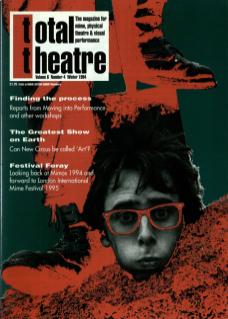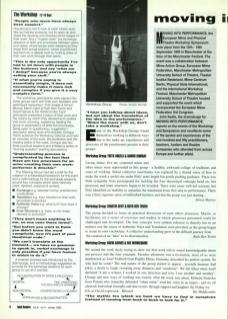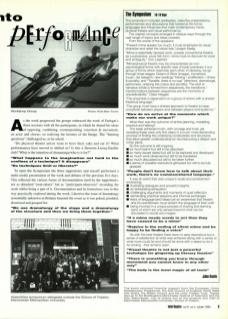The Workshop 12-16 September
‘People who move have always been suspect.’ Practitioners met to look at each other’s work. Not as finished products, but to open up and share the devising and developmental stages of their work. Not a ‘masterclass’ but exchange sessions of skills and processes between peers and styles, where issues were debated as they arose from actual practice; where practitioners reached into a deeper level by looking anew at their own work through their peers. ‘This is the only opportunity I've had to sit down with people in the business and say “what am I doing?” because you're always selling your stuff.’ ‘If what you're saying is essentially simple, it does not necessarily make it more rich and complex if you give it a very complex form.’
The workshop participants were placed into three groups each with their own facilitator and participant-rapporteur: Frits Vogels & Simon Murray, Martin Gent & Ruth Ben-Tovim, and David Gaines & Ris Widdicombe. Each participant presented a piece of their work and the means by which they devised and created that work, showing, explaining, leading the group in explorations of skills and processes, being open to questioning/suggestion/discussion about work and process. Enrique Pardo acted as the Workshop Director and held an overview of the work, the facilitation, and the creative paths of the week. Enrique also led three practical sessions and initiated a series of ‘burning question’ evening discussions. ‘Understanding process is complicated by the fact that there are two processes for an actor creating their own work: performer and director.’
The Steering Group had set a brief for the creation of a theoretical framework for the event and a methodology for the exchange sessions around four concepts which were variously used, rejected, explored and revised:
Exchange – e.g. between forms, practitioners, vocabularies.
Translation – e.g. from intention to final work, processes to product. Authentic Voice – e.g. what is it? how does it emerge?
Inner Structure – e.g. linear or non linear devised or authored?
‘They don't mean anything to me, no one uses these terms.’ ‘But before you went to Paris you didn't know the word complicité, now it's part of your theatrical code.’ ‘We can't translate at the moment... we have no grammar to speak in, verbal exchange is only possible if you have frames in which to do it.’
A forensic process was introduced by the dramaturg, and a methodology suggested as a model for the exchange sessions for each group to use as it wanted.
Workshop Reports
‘I hear you talking about ideas, but not about the translation of the idea to the performance.’ ‘Share the mess with us, don't take a workshop.’
Each of the Workshop Groups found themselves working in different ways due to the make up, experiences and processes of the practitioners present in their groups:
Workshop Group: Frits Vogels & Simon Murray
Lecoq, dance, live art, corporeal mime and other mixes were represented in this group – a healthy, awkward collage of traditions and ways of working. Initial collective uncertainty was replaced by a shared sense of how to make the week a useful one under Frits' arm’s length but gently probing guidance. There was little sympathy from participants for tackling the four theoretical concepts head on, but processes and inner structures began to be revealed. There were some well led sessions, but Frits identified an inability to articulate the translation from first idea to performance. There was a final vigorous sense of unfinished business and that the group was just starting...
Simon Murray
Workshop Group: Martin Gent & Ruth Ben-Tovim
The group decided to focus on practical discussion of each other’s processes. Martin, as facilitator, set a series of exercises and studies in which processes presented could be challenged and developed. The four concepts were seldom referred to directly but in an indirect way the issues of Authentic Voice and Translation were prevalent as the group began to create its own vocabulary. A collective understanding grew of the difficult journey from the creation of an ‘idea’ to its dissemination.
Ruth Ben-Tovim
Workshop Group: David Gaines & Ris Widdicombe
We started the week shyly, trying to show our best work and to sound knowledgeable about our process and the four concepts. Tuesday afternoon was a revelation, most of us were dumbstruck as Josef Frohlich from Papillo Mime, Germany, described his perfect system. So why had he come? The real nature of the group started to appear – juvenile humour, bad jokes, a desire to laugh sweeping away distances and ‘academia’. We felt lifted when Josef declared ‘I am a winner. I worked in one direction and now I see another and another.’ Change and new ways of working was exactly what the week was about. Elsbetia Pastecka from Poland who staunchly defended ‘silent mime’ used her voice in an impro – and we all cheered! Individual triumphs and discoveries through support and laughter. By Friday we felt, as David expressed... Blessed.
Ris Widdicombe
‘The mythic fox which we hunt we have to find in ourselves instead of running from bush to bush to look for it.’
As the week progressed the groups embraced the work of Enrique's three sessions with all the participants, in which he shared his ideas of opposing, combining, counterpointing voice/text and movement; on actor and chorus; on realising the Instinct of the Image. The ‘burning questions’ challenged us, as he asked:
‘Do physical theatre artists want to have their cake and eat it? What performances have moved i.e. shifted us? Is this a Decroux-Lecoq-Gaulier club? What is the intention of dramaturgy / who is it for?’ ‘What happens to the imagination not held in the confines of a technique? It disappears.’ ‘Do techniques limit or liberate?’
To open the Symposium the three rapporteurs and myself performed a multimedia presentation of the work and debates of the previous five days.
This reflected the various forms of documentation used by the rapporteurs, not as detached ‘note-takers’ but as ‘participant observers’ recording the work whilst being a part of it. Documentation and its forms/uses was in this way practically explored during the week. Likewise the issue of dramaturgy (essentially unknown in Britain) haunted the event as it was poked, prodded, dismissed and grasped for: ‘We use dramaturgy of the stage and a dramaturgy of the structure and then we bring them together.’
The Symposium 16-18 Sept
The symposium included addresses, video/live presentations, performances and discussions that looked at the forms, languages and influences that mark contemporary mime, physical theatre and visual performance.
The original concepts emerged in oblique ways through the vast range of topics and ideas covered.
From the words of the speakers:
‘Present mime speaks too much; it must emphasise its visual character and resist the verbal tide.’ – Joseph Seelig
‘Mime is essentially devised work, outside conventional theatre as a subversive, vocal folk form; mime must re-discover its voice and ambiguity.’ – Tom Leabhart
‘Mime / physical theatre may be characterised as non-psychological forms with specific sets of body practices, it is a group of forms which resemble each other. In devising, we go through three stages: Dream of Work (images, movement, music, old research, new reading): Training / proliferation / chaos & plurality; and “Traveller, there is no way” (directors, dramaturg. performers, ordering the chaos and plurality). The recit or narrative whole is formed from sequences, the transitions / transformations between sequences are the moments of unpredictability.’ – Claire Heggen
‘The ensemble is dependent on a group of actors with a shared theatrical language.’
‘The group must have a shared approach to theatre to keep complicité between players and between players and audience.’
‘How do we arrive at the moments which make our work unique?’
What then was the outcome of all the planning, modelling, practice and talking?
The week achieved much, with courage and trust; yet revealing these were only first steps in a much more demanding process of finding the underlying vocabularies and structures that allow greater understanding for reconstructing a deeper and richer piece.
So the outcome is still ongoing: so much learnt but still to be absorbed, so many issues raised but still to be explored and developed, so much work observed but still to be translated, so much discussed but still to be taken further, a sense of possible resolutions glimpsed but still to be fully grasped. ‘People don't know how to talk about their work, there's no common/shared language.’
It was an event that was unique in scale and achievement, embracing: frustrating dialogues and powerful insights; an exhilarating exhaustion; challenging arguments and moments of quiet reflection; demanding practical sessions and informal exchanges; fears of language (and ideas) yet an awareness that theatre and its practitioners must reclaim the language of their craft; being involved in a unique process of sharing and leaming parts of which are only sensed beyond what can be articulated in words and images. ‘If a mime needs words to act then they have ceased to be a mime.’ ‘Rejoice in the ending of silent mime and be happy to be finding a voice.’
As with the best theatre there were no easy resolutions but a sense of satisfaction at what was achieved along with a sense of what more could be and should be done with a desire to do it. An ending – that remains open. ‘Visual theatre is not just a powerful technique for gingering up literary theatre.’ ‘There is something you know through movement you cannot know in any other way.’
‘The body is the most magic of all tools.’
The event received financial support from the European Union Kaleidoscope Programme, the Arts Council of England, North West Arts Board, the British Council, and the Unity Theatre Trust. Thanks also go to the Boddingtons Manchester Festival of Television and the Arts, Manchester City of Drama, and all the students and staff of Manchester Metropolitan University, School of Theatre.


